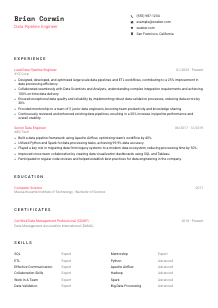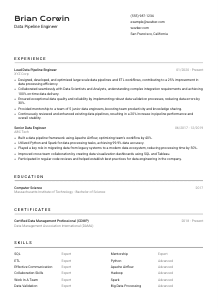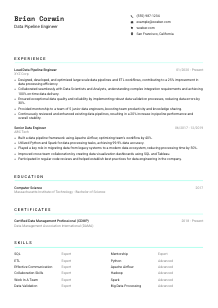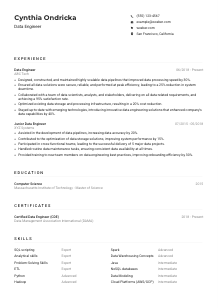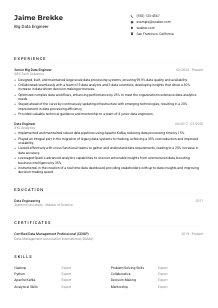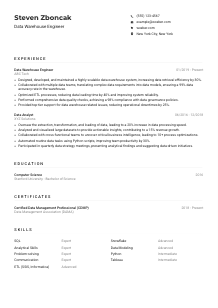Data Pipeline Engineer Resume Example
Building data highways, but your resume feels like a traffic jam? Explore this Data Pipeline Engineer resume example, constructed with Wozber free resume builder. Grasp how adeptly you can channel your data-routing brilliance to sync with job requirements, ensuring your career flows along as efficiently as the systems you design!
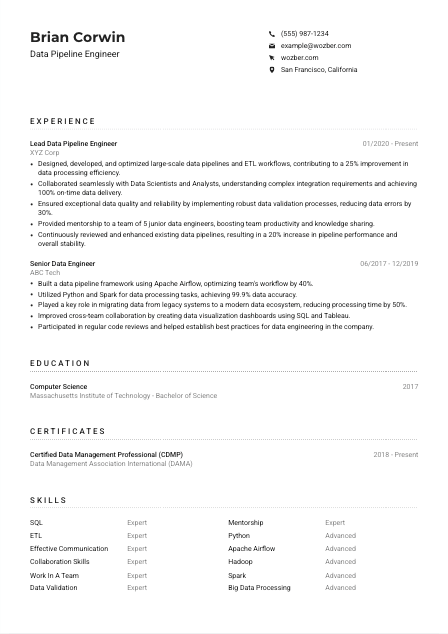
How to write a Data Pipeline Engineer Resume?
Embark on a journey to unlock the secrets of a standout Data Pipeline Engineer resume. In the fast-paced tech arena, distinguishing yourself is paramount. Here lies your blueprint, orchestrated with the finesse of Wozber's free resume builder, to tailor your resume seamlessly to the job at hand.
Using an ATS-friendly resume format and the precision of ATS optimization, this guide is your compass to navigate through the creation of your career-defining document. Let's begin sculpting your narrative, making your data engineering prowess irresistibly clear to your future employer.
Personal Details
The Personal Details section is your virtual handshake. It might appear straightforward, yet it's the cornerstone of your professional introduction. By aligning this section with the Data Pipeline Engineer's job nuances, you pave your initial path towards securing that interview. Let's refine it with the precision of a well-optimized data query.
1. Your Name: Your Professional Identity
Imagine your name in bold letters, a beacon among the sea of candidates. It's not just a name; it's your brand. Opt for a clear font, perhaps Arial or Calibri, making it prominently visible. This isn't just typography; it's your first claim of professionalism.
2. Job Title Alignment: Speak Their Language
Right below your name, etch the job title you're targeting: Data Pipeline Engineer. This alignment is not trivial. It signals to the hiring manager and the ATS that you're not just a hopeful applicant but a focused candidate with clear intentions.
3. Essential Contact Details: The Bridge
Your phone number is your direct line, your email, the inbox to your professional persona. Use an email format that's both simple and professional. Typos here are like bugs in a code; they could crash your chances before you even start. Double-check for accuracy.
4. Location Matters: No Relocation Hassles
San Francisco, California - let this shine in your details. It's not just a location; it's an assurance to your future employer about your immediate availability and eliminates any concerns regarding relocation, setting the stage for a smoother hiring process.
5. Online Presence: The Extra Mile
Linking a LinkedIn profile or a personal website could be the gateway to showcasing your projects and skills further. Ensure it's aligned with the data on your resume. This isn't just about showing where you've been; it's about offering a window into your professional journey.
Takeaway
Crafted right, your Personal Details section does more than share your contact info; it establishes your professional identity and readiness. With each detail, you're telling your story, opening the narrative of a Data Pipeline Engineer ready to tackle the challenges ahead. Position these details as strategically as you would a data set in your pipeline. The precision, the clarity, they set the tone for the resume that follows.





Experience
Dive into the heart of your resume: the Experience section. As a Data Pipeline Engineer, your journey through various projects and achievements is your testament to excellence. It's not just about listing your past roles; it's about illustrating your journey, your growth, and the tangible impact you've had. Let's map out how to align your experience with what your dream job is asking for.
- Designed, developed, and optimized large‑scale data pipelines and ETL workflows, contributing to a 25% improvement in data processing efficiency.
- Collaborated seamlessly with Data Scientists and Analysts, understanding complex integration requirements and achieving 100% on‑time data delivery.
- Ensured exceptional data quality and reliability by implementing robust data validation processes, reducing data errors by 30%.
- Provided mentorship to a team of 5 junior data engineers, boosting team productivity and knowledge sharing.
- Continuously reviewed and enhanced existing data pipelines, resulting in a 20% increase in pipeline performance and overall stability.
- Built a data pipeline framework using Apache Airflow, optimizing team's workflow by 40%.
- Utilized Python and Spark for data processing tasks, achieving 99.9% data accuracy.
- Played a key role in migrating data from legacy systems to a modern data ecosystem, reducing processing time by 50%.
- Improved cross‑team collaboration by creating data visualization dashboards using SQL and Tableau.
- Participated in regular code reviews and helped establish best practices for data engineering in the company.
1. Dissecting the Job Description
Start by breaking down the provided job description. Keywords like 'designing, building, and maintaining scalable data pipelines' are not just phrases; they are your guiding stars. Your role is to reflect these requirements through your past achievements, creating a mirror image of your potential future successes.
2. Chronological Harmony
Arrange your roles from the most recent to the oldest, ensuring a logical flow that a hiring manager (or an ATS) can easily follow. Each position you held is a chapter of your story, showcasing growth, responsibilities, and success. Ensure this narrative is linear and coherent.
3. Crafting Achievements That Resonate
When detailing your responsibilities and achievements, let the job's requirements guide you. For example, if the job emphasizes 'ensuring data quality and reliability,' highlight how you implemented data validation processes or reduced data errors. These achievements act as proof of your capability to meet and exceed the job's demands.
4. Quantify Your Impact
Numbers speak volumes. Whether it's the percentage of efficiency improvement or the number of data errors reduced, these figures offer a tangible measure of your contribution. They transform your tasks into undeniable achievements, painting a picture of efficiency and expertise.
5. Relevance Over Quantity
While it might be tempting to list all your experiences, focus on those directly relevant to the role of a Data Pipeline Engineer. Quality trumps quantity every time. This selective approach ensures that every bullet point on your resume is a testament to your suitability for the role.
Takeaway
Imagine each line of your Experience section as a dataset, each crafted to highlight your expertise, your growth, and the results you've achieved. This isn't just about the past; it's a predictive model of your potential future impact. Make each word count, and let your journey leap off the page, compelling the hiring manager to see you in action as their next Data Pipeline Engineer.
Education
Your Education section is more than a mere list of qualifications; it's the bedrock of your knowledge and skills as a Data Pipeline Engineer. In a field that prides itself on precision and expertise, how you present your academic journey can significantly influence your resume's impact. Let's delve into how to sculpt this section to underscore your qualifications.
1. Aligning with Job Requirements
The role specifies a 'Bachelor's degree in Computer Science, Engineering, or a related field.' It's not just a box to tick; it's a key requirement you match. Ensure your degree is highlighted prominently, mirroring the job's demands and underscoring your eligibility.
2. Clarity and Precision
Adopt a straightforward format listing your degree, the institution, and your graduation date. This clarity is akin to good code; it's clean, efficient, and understandable at a glance, leaving no room for ambiguity about your academic credentials.
3. Degree Relevance
If your degree directly matches the job's educational requirements, give it the spotlight. For instance, a 'Bachelor of Science in Computer Science' should be front and center if that's what you hold, directly aligning with the role's specifications.
4. Course Highlights
For roles deeply embedded in technology and methodologies, mentioning relevant coursework can bolster your qualifications, especially if your experience is more limited. Lean on courses like 'Data Structures,' 'Database Management,' or 'Distributed Systems,' which speak directly to the heart of a Data Pipeline Engineer's role.
5. Additional Achievements
If you have academic accomplishments that resonate with the role—think honors, relevant projects, or extracurricular engagements—mention them. They add depth to your profile, showcasing a commitment to your field beyond the classroom. However, gauge their relevance based on your career level; the more seasoned you are, the more your professional experience will speak for itself.
Takeaway
Your education section isn't just a chronicle of your academic journey; it's evidence of your foundational knowledge and dedication to your craft. It's the lineage of your expertise. Tailor it with care, ensuring it serves as a clear indicator of your qualifications and how they precisely fit the role of a Data Pipeline Engineer.
Certificates
In the dynamic realm of Data Pipeline Engineering, certifications serve as a testament to your continued growth and adaptability to changing technologies. While the job description did not mandate certifications, including them can set you apart, demonstrating your dedication and specialized knowledge. Here's how you tap into this reservoir of potential.
1. Reflect on Key Skills
Skim through the job description for skills that could be reinforced by certifications. While the role did not list specific certificates, acquiring ones like 'Certified Data Management Professional (CDMP)' aligns with the job's essence, articulating your commitment and expertise.
2. Highlight Pertinent Certifications
In choosing which certificates to list, quality trumps quantity. Highlight the certifications that closely match the role's technical requirements and soft skills. This selective showcasing ensures your resume remains focused and relevant, not diluted by non-essential information.
3. Date Precision
Including the acquisition or expiration dates of your certifications can be beneficial, offering clarity on the currency of your expertise. This transparency is akin to version control in software development; it showcases the relevance and timeliness of your skill set.
4. Stay on the Cutting Edge
The tech field evolves rapidly. Regularly updating your certifications, and by extension, your resume, signals your dedication to keeping pace with the industry's advancements. This constant evolution is not just about personal growth; it's a statement of your commitment to excellence.
Takeaway
Consider each certificate as a micro-credential, each telling a story of learning, adaptation, and mastery. They are your silent advocates, underscoring your commitment to staying at the forefront of the Data Pipeline Engineering field. Let them shine as testamentary pieces of your unwavering commitment to professional growth and excellence.
Skills
The Skills section of your resume is where you get to showcase your technical prowess and soft skills, each a critical component in the Data Pipeline Engineer's toolkit. This isn't just a list; it's a curated collection of your capabilities, ready to solve the puzzles the job demands. Let's take a strategic approach to aligning your skills with the position's specifics.
1. Decoding the Job Specs
Commence with a deep dive into the job description. Identify both the hard skills like 'SQL,' 'Python,' and 'Apache Airflow,' and soft skills like 'Effective Communication' and 'Collaboration Skills.' These aren't just keywords; they are the languages of your profession, essential to navigating the complexities of data pipeline engineering.
2. Precision Matching
Once you've isolated these skills, it's time to mirror them with your own. This reflection isn't mere replication; it's about matching your arsenal with the job's demands. Each skill listed is a tick in the compatibility checklist, making your resume a bespoke fit for the role.
3. Strategic Organization
Resist the urge to flood this section with every skill in your repertoire. Prioritize those that directly align with the job description, ensuring clarity and relevance. Think of it as the principle of ‘less is more'—a concentrated showcase of your most relevant skills that speaks directly to the needs of your potential employer.
Takeaway
Your skills section is where potent potential meets strategic showcase. It's your opportunity to firmly assert your fit for the Data Pipeline Engineer role. Tailor it, prioritize it, and let it speak volumes of your readiness to tackle the data challenges that lie ahead. These are not just skills; they are your tools for building the future.
Languages
In a global tech landscape, language proficiency can markedly enhance your appeal to a diverse employer base. While the job description emphasized English, your multilingual abilities can be a unique selling point, reflecting your readiness for a global stage. Let's navigate the nuances of presenting your linguistic capabilities.
1. Job Requirements Check
Begin by ensuring your resume clearly states your proficiency in English, as 'Must possess good command over the English language' was specified. This isn't just meeting a requirement; it's demonstrating your readiness to communicate effectively in a global tech environment.
2. Prioritizing Relevant Languages
Lead with the languages most pertinent to the job, ranking them from most to least proficient. This hierarchy isn't just about fluency; it's a subtle indicator of your ability to navigate multilingual environments, a valuable asset in diverse teams.
3. Comprehensive Listing
While English takes precedence, don't shy away from mentioning other languages you're conversant with. Each language you list expands your potential reach and showcases a facet of your adaptability and cultural sensibility—traits that enrich teams and projects.
4. Transparent Proficiency Levels
Clarity in detailing your language proficiency is key. Use terms like 'Native,' 'Fluent,' 'Intermediate,' and 'Basic' to accurately represent your linguistic capabilities. This transparency sets clear expectations and showcases your honesty—a prized soft skill in any profession.
5. Evaluating the Role's Scope
Consider the broader context of the role. If the position entails international collaboration or client interactions across different regions, your multilingual skills become even more significant. Highlighting these capabilities could set you apart in a competitive applicant pool.
Takeaway
Your linguistic skills reflect more than the ability to communicate; they embody adaptability, cultural intelligence, and a readiness for global interaction. Emphasize them, especially your proficiency in English, aligned with the job requirements, and let them open doors to a world where your skills can thrive and make a difference.
Summary
Your summary is more than a brief introduction; it's your elevator pitch, your chance to grab the hiring manager's attention. As a Data Pipeline Engineer, how you present your experience, skills, and aspirations in a few succinct lines can set the tone for the rest of your resume. Let's distill the essence of your professional journey into a compelling narrative.
1. Capturing the Job's Essence
Dive into understanding the role's core requirements and how your journey aligns with them. This isn't just about repeating what they're looking for; it's about convincing them that what you offer is what they need. Start with a clear statement of your professional identity: 'Data Pipeline Engineer with over 4 years of experience…'
2. Leading with Experience and Skills
Weave in a brief mention of the skills that make you standout: SQL, Python, Apache Airflow, among others. But don't stop there. Highlight your achievements, like how your work 'contributed to a 25% improvement in data processing efficiency.' This isn't just listing; it's proving your worth.
3. Addressing the Fit
Directly reference how your capabilities align with the role's needs. If teamwork and communication are emphasized, mention your 'proven ability to collaborate with cross-functional teams.' Make it clear that not only do you fit their criteria, you exceed it.
4. Brevity is Power
This section should be sharp and to the point, akin to the executive summary of a report. Pack it with impactful information, but keep it digestible. Aim for a balance of brevity and substance that entices the hiring manager to delve deeper into your resume.
Takeaway
Consider your summary as the opening act of your professional showcase. It's your moment to engage, entice, and inform, setting the stage for the detailed brilliance that follows. A well-crafted summary doesn't just recount your past; it heralds your future successes. Let it be the beacon that guides the hiring manager to recognize you as the ideal candidate for their Data Pipeline Engineer role.
Launching Your Data Pipeline Engineer Journey
Congratulations on meticulously tailoring your Data Pipeline Engineer resume. Armed with the guidance provided, your resume is not just a document; it's a testament to your dedication and proficiency in the world of data engineering. Use Wozber's free resume builder, including the free ATS-friendly resume templates and the ATS resume scanner for keywords optimization, as your ally in this quest. As you propel your career forward, remember that each submission is a step towards your next achievement. The journey of a thousand pipelines begins with a single resume.
Let yours open the door to new opportunities, new challenges, and the chance to make an indelible mark in the data engineering landscape. Your future awaits, illuminated by the data you master and the paths you'll pave. Go forth, engineer your destiny!

- Bachelor's degree in Computer Science, Engineering, or a related field.
- Minimum of 3 years of experience in designing, building, and maintaining scalable data pipelines.
- Strong proficiency in SQL, Python, and experience with ETL tools such as Apache Airflow and Apache Nifi.
- In-depth knowledge of big data processing frameworks like Hadoop and Spark.
- Effective communication and collaboration skills, with the ability to work in a team-oriented environment.
- Must possess good command over English language.
- Must be located in San Francisco, California.
- Design, develop, and optimize large-scale data pipelines and ETL workflows to support business intelligence and analytics use cases.
- Collaborate with cross-functional teams, including Data Scientists and Analysts, to understand data integration requirements and priorities.
- Ensure data quality and reliability by developing and implementing data validation and monitoring processes.
- Provide technical guidance and mentorship to junior data engineers in the team.
- Continuously review and improve existing data pipelines for enhanced performance and stability.





